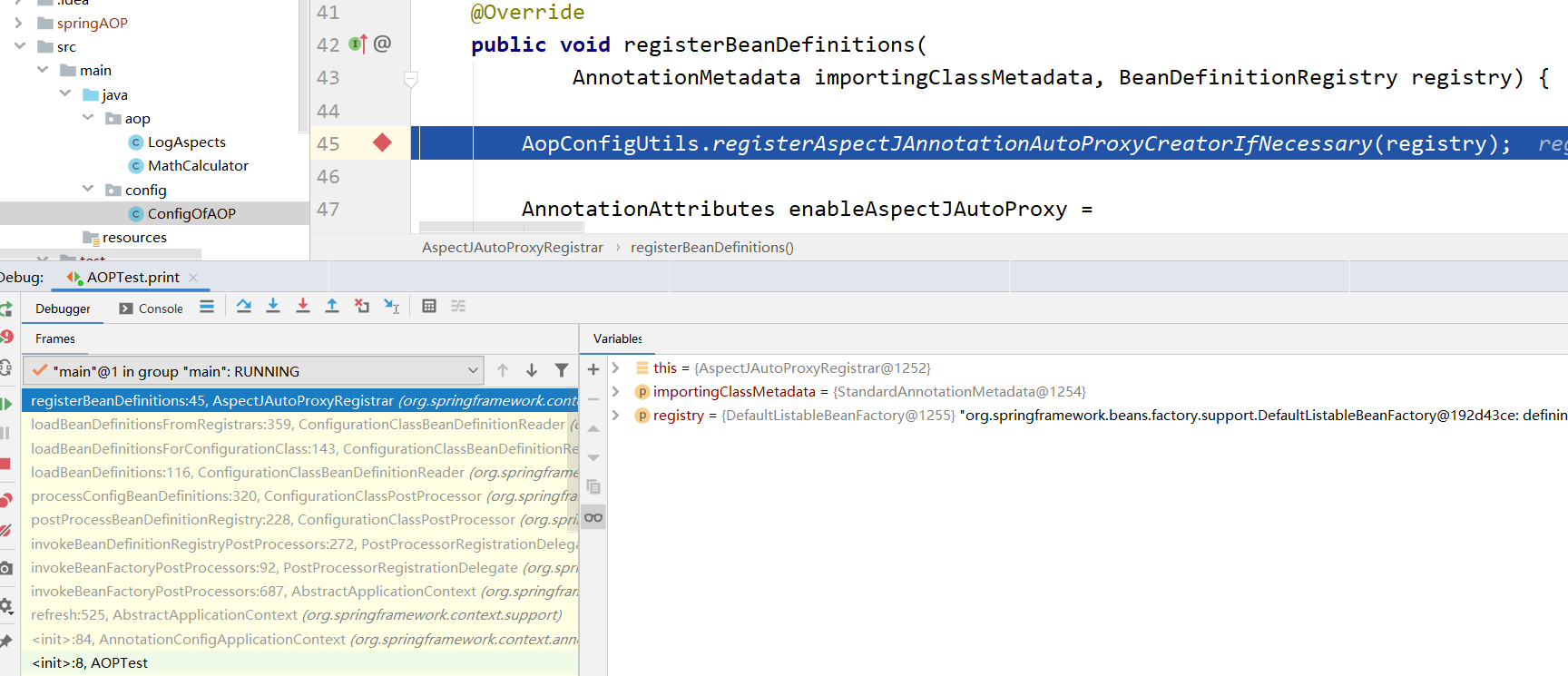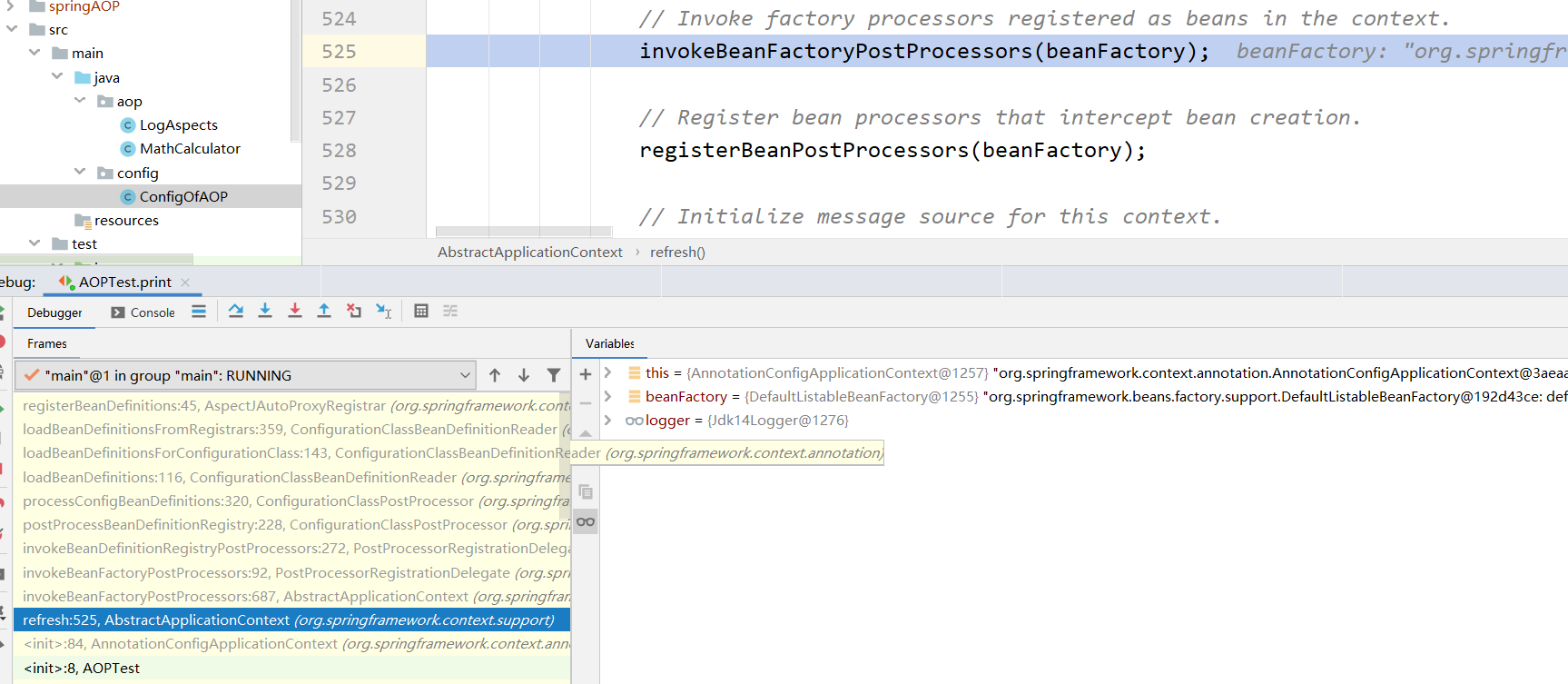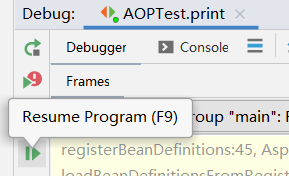Spring——AOP原理及源码二【系列完】
回顾:
在上一篇中,我们提到@EnableAspectJAutoProxy注解给容器中加入了一个关键组件internalAutoProxyCreator的BeanDefinition,实际类型为
AnnotationAwareAspectJAutoProxyCreator的BeanDenation
并且发现这是一个后置处理器,也是一个XXXAware接口的实现类。以及探究了它的继承关系如下。

接下来我们就从后置处理器和BeanFactoryAware的角度来看看AnnotationAwareAspectJAutoProxyCreator的BeanDefinition创建完成后都做了什么。
一、设置调试断点
我们分别进入四个有关类,在类中与后置处理器和BeanFactoryAware有关的方法上打上断点。最终效果如下:
AbstractAutoProxyCreator.setBeanFactory
AbstractAutoProxyCreator有后置处理器逻辑
{
postProcessBeforeInstantiation()
postProcessAfterInitialization()
}
AbstractAdvisorAutoProxyCreator.initBeanFactory
AbstractAdvisorAutoProxyCreator.setBeanFactory
AnnotationAwareAspectJAutoProxyCreator.initBeanFactory
最后,在配置类中给两个bean方法打上断点。
二、调试过程
开始调试,我们会发现还是先来到上一篇的AnnotationAwareAspectJAutoProxyCreator的BeanDenation创建过程。

左下角frames框中选到refresh方法可以看到,AnnotationAwareAspectJAutoProxyCreator的BeanDenation的创建是invokeBeanFactoryPostProcessors()方法调用来的。
调用这个方法在上下文中生成后置处理器的BeanDefinition加入容器中。
下一步的registerBeanPostProcessors才是注册后置处理器(利用BeanDefinition的信息注册对应Bean),也是本篇的重点。

为了让它快速创建完BeanDefinition,这里我们直接快进到下一个断点。

程序先来到了AbstractAdvisorAutoProxyCreator的setBeanFactory方法

为了从头看起,还是先在frames框中选到refresh方法,可以看到来到了refresh的下一方法,将要开始注册后置处理器。
![]()
1、registerBeanPostProcessors()
我们继续在frames中往上点,直到来到PostProcessorRegistrationDelegate.registerBeanPostProcessors()

方法有点长,但关键只在其中几个地方,我们将在下面进行针对分析

1 public static void registerBeanPostProcessors( 2 ConfigurableListableBeanFactory beanFactory, AbstractApplicationContext applicationContext) { 3 4 String[] postProcessorNames = beanFactory.getBeanNamesForType(BeanPostProcessor.class, true, false); 5 6 // Register BeanPostProcessorChecker that logs an info message when 7 // a bean is created during BeanPostProcessor instantiation, i.e. when 8 // a bean is not eligible for getting processed by all BeanPostProcessors. 9 int beanProcessorTargetCount = beanFactory.getBeanPostProcessorCount() + 1 + postProcessorNames.length; 10 beanFactory.addBeanPostProcessor(new BeanPostProcessorChecker(beanFactory, beanProcessorTargetCount)); 11 12 // Separate between BeanPostProcessors that implement PriorityOrdered, 13 // Ordered, and the rest. 14 List<BeanPostProcessor> priorityOrderedPostProcessors = new ArrayList<BeanPostProcessor>(); 15 List<BeanPostProcessor> internalPostProcessors = new ArrayList<BeanPostProcessor>(); 16 List<String> orderedPostProcessorNames = new ArrayList<String>(); 17 List<String> nonOrderedPostProcessorNames = new ArrayList<String>(); 18 for (String ppName : postProcessorNames) { 19 if (beanFactory.isTypeMatch(ppName, PriorityOrdered.class)) { 20 BeanPostProcessor pp = beanFactory.getBean(ppName, BeanPostProcessor.class); 21 priorityOrderedPostProcessors.add(pp); 22 if (pp instanceof MergedBeanDefinitionPostProcessor) { 23 internalPostProcessors.add(pp); 24 } 25 } 26 else if (beanFactory.isTypeMatch(ppName, Ordered.class)) { 27 orderedPostProcessorNames.add(ppName); 28 } 29 else { 30 nonOrderedPostProcessorNames.add(ppName); 31 } 32 } 33 34 // First, register the BeanPostProcessors that implement PriorityOrdered. 35 sortPostProcessors(priorityOrderedPostProcessors, beanFactory); 36 registerBeanPostProcessors(beanFactory, priorityOrderedPostProcessors); 37 38 // Next, register the BeanPostProcessors that implement Ordered. 39 List<BeanPostProcessor> orderedPostProcessors = new ArrayList<BeanPostProcessor>(); 40 for (String ppName : orderedPostProcessorNames) { 41 BeanPostProcessor pp = beanFactory.getBean(ppName, BeanPostProcessor.class); 42 orderedPostProcessors.add(pp); 43 if (pp instanceof MergedBeanDefinitionPostProcessor) { 44 internalPostProcessors.add(pp); 45 } 46 } 47 sortPostProcessors(orderedPostProcessors, beanFactory); 48 registerBeanPostProcessors(beanFactory, orderedPostProcessors); 49 50 // Now, register all regular BeanPostProcessors. 51 List<BeanPostProcessor> nonOrderedPostProcessors = new ArrayList<BeanPostProcessor>(); 52 for (String ppName : nonOrderedPostProcessorNames) { 53 BeanPostProcessor pp = beanFactory.getBean(ppName, BeanPostProcessor.class); 54 nonOrderedPostProcessors.add(pp); 55 if (pp instanceof MergedBeanDefinitionPostProcessor) { 56 internalPostProcessors.add(pp); 57 } 58 } 59 registerBeanPostProcessors(beanFactory, nonOrderedPostProcessors); 60 61 // Finally, re-register all internal BeanPostProcessors. 62 sortPostProcessors(internalPostProcessors, beanFactory); 63 registerBeanPostProcessors(beanFactory, internalPostProcessors); 64 65 // Re-register post-processor for detecting inner beans as ApplicationListeners, 66 // moving it to the end of the processor chain (for picking up proxies etc). 67 beanFactory.addBeanPostProcessor(new ApplicationListenerDetector(applicationContext)); 68 }
4:获取所有后置处理器的名字
14~32:对实现不同接口的后置处理器进行分类
35~48:对上面的分类分别进行处理,因为实现的是Ordered接口,我们只关注39~48行

40~46:遍历分好的实现了Ordered接口的后置处理器名,利用beanFactory.getBean(ppName, BeanPostProcessor.class)来获取
2、doGetBean()
有了以上的步骤,我们主要来看beanFactory是怎么获取的

可以看到,先来到了getBean方法,然后又进入了doGetBean方法。下面我们来看doGetBean做了什么。

1 /** 2 * Return an instance, which may be shared or independent, of the specified bean. 3 * @param name the name of the bean to retrieve 4 * @param requiredType the required type of the bean to retrieve 5 * @param args arguments to use when creating a bean instance using explicit arguments 6 * (only applied when creating a new instance as opposed to retrieving an existing one) 7 * @param typeCheckOnly whether the instance is obtained for a type check, 8 * not for actual use 9 * @return an instance of the bean 10 * @throws BeansException if the bean could not be created 11 */ 12 @SuppressWarnings("unchecked") 13 protected <T> T doGetBean( 14 final String name, final Class<T> requiredType, final Object[] args, boolean typeCheckOnly) 15 throws BeansException { 16 17 final String beanName = transformedBeanName(name); 18 Object bean; 19 20 // Eagerly check singleton cache for manually registered singletons. 21 Object sharedInstance = getSingleton(beanName); 22 if (sharedInstance != null && args == null) { 23 if (logger.isDebugEnabled()) { 24 if (isSingletonCurrentlyInCreation(beanName)) { 25 logger.debug("Returning eagerly cached instance of singleton bean '" + beanName + 26 "' that is not fully initialized yet - a consequence of a circular reference"); 27 } 28 else { 29 logger.debug("Returning cached instance of singleton bean '" + beanName + "'"); 30 } 31 } 32 bean = getObjectForBeanInstance(sharedInstance, name, beanName, null); 33 } 34 35 else { 36 // Fail if we're already creating this bean instance: 37 // We're assumably within a circular reference. 38 if (isPrototypeCurrentlyInCreation(beanName)) { 39 throw new BeanCurrentlyInCreationException(beanName); 40 } 41 42 // Check if bean definition exists in this factory. 43 BeanFactory parentBeanFactory = getParentBeanFactory(); 44 if (parentBeanFactory != null && !containsBeanDefinition(beanName)) { 45 // Not found -> check parent. 46 String nameToLookup = originalBeanName(name); 47 if (args != null) { 48 // Delegation to parent with explicit args. 49 return (T) parentBeanFactory.getBean(nameToLookup, args); 50 } 51 else { 52 // No args -> delegate to standard getBean method. 53 return parentBeanFactory.getBean(nameToLookup, requiredType); 54 } 55 } 56 57 if (!typeCheckOnly) { 58 markBeanAsCreated(beanName); 59 } 60 61 try { 62 final RootBeanDefinition mbd = getMergedLocalBeanDefinition(beanName); 63 checkMergedBeanDefinition(mbd, beanName, args); 64 65 // Guarantee initialization of beans that the current bean depends on. 66 String[] dependsOn = mbd.getDependsOn(); 67 if (dependsOn != null) { 68 for (String dep : dependsOn) { 69 if (isDependent(beanName, dep)) { 70 throw new BeanCreationException(mbd.getResourceDescription(), beanName, 71 "Circular depends-on relationship between '" + beanName + "' and '" + dep + "'"); 72 } 73 registerDependentBean(dep, beanName); 74 getBean(dep); 75 } 76 } 77 78 // Create bean instance. 79 if (mbd.isSingleton()) { 80 sharedInstance = getSingleton(beanName, new ObjectFactory<Object>() { 81 @Override 82 public Object getObject() throws BeansException { 83 try { 84 return createBean(beanName, mbd, args); 85 } 86 catch (BeansException ex) { 87 // Explicitly remove instance from singleton cache: It might have been put there 88 // eagerly by the creation process, to allow for circular reference resolution. 89 // Also remove any beans that received a temporary reference to the bean. 90 destroySingleton(beanName); 91 throw ex; 92 } 93 } 94 }); 95 bean = getObjectForBeanInstance(sharedInstance, name, beanName, mbd); 96 } 97 98 else if (mbd.isPrototype()) { 99 // It's a prototype -> create a new instance. 100 Object prototypeInstance = null; 101 try { 102 beforePrototypeCreation(beanName); 103 prototypeInstance = createBean(beanName, mbd, args); 104 } 105 finally { 106 afterPrototypeCreation(beanName); 107 } 108 bean = getObjectForBeanInstance(prototypeInstance, name, beanName, mbd); 109 } 110 111 else { 112 String scopeName = mbd.getScope(); 113 final Scope scope = this.scopes.get(scopeName); 114 if (scope == null) { 115 throw new IllegalStateException("No Scope registered for scope name '" + scopeName + "'"); 116 } 117 try { 118 Object scopedInstance = scope.get(beanName, new ObjectFactory<Object>() { 119 @Override 120 public Object getObject() throws BeansException { 121 beforePrototypeCreation(beanName); 122 try { 123 return createBean(beanName, mbd, args); 124 } 125 finally { 126 afterPrototypeCreation(beanName); 127 } 128 } 129 }); 130 bean = getObjectForBeanInstance(scopedInstance, name, beanName, mbd); 131 } 132 catch (IllegalStateException ex) { 133 throw new BeanCreationException(beanName, 134 "Scope '" + scopeName + "' is not active for the current thread; consider " + 135 "defining a scoped proxy for this bean if you intend to refer to it from a singleton", 136 ex); 137 } 138 } 139 } 140 catch (BeansException ex) { 141 cleanupAfterBeanCreationFailure(beanName); 142 throw ex; 143 } 144 } 145 146 // Check if required type matches the type of the actual bean instance. 147 if (requiredType != null && bean != null && !requiredType.isInstance(bean)) { 148 try { 149 return getTypeConverter().convertIfNecessary(bean, requiredType); 150 } 151 catch (TypeMismatchException ex) { 152 if (logger.isDebugEnabled()) { 153 logger.debug("Failed to convert bean '" + name + "' to required type '" + 154 ClassUtils.getQualifiedName(requiredType) + "'", ex); 155 } 156 throw new BeanNotOfRequiredTypeException(name, requiredType, bean.getClass()); 157 } 158 } 159 return (T) bean; 160 }
17:获取后置处理器的名称(这里也就是internalAutoProxyCreator)
21:根据bean名字获取对应单例
22~33:如果获取到的bean不为空,进行一系列操作(这里的internalAutoProxyCreator是第一次获取,bean应该是空,所以我们跳过22~33)
61:getMergedLocalBeanDefinition() 根据传入的后置处理器名称,获取其所有信息,在这里也就是从internalAutoProxyCreator的BeanDefinition中获取必要信息,这是为创建bean做准备。
79:判断如果是单例,调用getSingleton()来获取
这里我们先不急着进入getSingleton()方法,接着往下看先。
130:bean = getObjectForBeanInstance(scopedInstance, name, beanName, mbd) 将79行获取的scopedInstance包装为bean
159:返回bean
ok,getSingleton()的获取是要返回的,所以这步是关键,接下来我们来看看getSingleton()。

一直往上走,最终我们来到doCreateBean(),说明获取不到,接下来需要创建bean了
3、doCreateBean()

1 /** 2 * Actually create the specified bean. Pre-creation processing has already happened 3 * at this point, e.g. checking {@code postProcessBeforeInstantiation} callbacks. 4 * <p>Differentiates between default bean instantiation, use of a 5 * factory method, and autowiring a constructor. 6 * @param beanName the name of the bean 7 * @param mbd the merged bean definition for the bean 8 * @param args explicit arguments to use for constructor or factory method invocation 9 * @return a new instance of the bean 10 * @throws BeanCreationException if the bean could not be created 11 * @see #instantiateBean 12 * @see #instantiateUsingFactoryMethod 13 * @see #autowireConstructor 14 */ 15 protected Object doCreateBean(final String beanName, final RootBeanDefinition mbd, final Object[] args) 16 throws BeanCreationException { 17 18 // Instantiate the bean. 19 BeanWrapper instanceWrapper = null; 20 if (mbd.isSingleton()) { 21 instanceWrapper = this.factoryBeanInstanceCache.remove(beanName); 22 } 23 if (instanceWrapper == null) { 24 instanceWrapper = createBeanInstance(beanName, mbd, args); 25 } 26 final Object bean = (instanceWrapper != null ? instanceWrapper.getWrappedInstance() : null); 27 Class<?> beanType = (instanceWrapper != null ? instanceWrapper.getWrappedClass() : null); 28 mbd.resolvedTargetType = beanType; 29 30 // Allow post-processors to modify the merged bean definition. 31 synchronized (mbd.postProcessingLock) { 32 if (!mbd.postProcessed) { 33 try { 34 applyMergedBeanDefinitionPostProcessors(mbd, beanType, beanName); 35 } 36 catch (Throwable ex) { 37 throw new BeanCreationException(mbd.getResourceDescription(), beanName, 38 "Post-processing of merged bean definition failed", ex); 39 } 40 mbd.postProcessed = true; 41 } 42 } 43 44 // Eagerly cache singletons to be able to resolve circular references 45 // even when triggered by lifecycle interfaces like BeanFactoryAware. 46 boolean earlySingletonExposure = (mbd.isSingleton() && this.allowCircularReferences && 47 isSingletonCurrentlyInCreation(beanName)); 48 if (earlySingletonExposure) { 49 if (logger.isDebugEnabled()) { 50 logger.debug("Eagerly caching bean '" + beanName + 51 "' to allow for resolving potential circular references"); 52 } 53 addSingletonFactory(beanName, new ObjectFactory<Object>() { 54 @Override 55 public Object getObject() throws BeansException { 56 return getEarlyBeanReference(beanName, mbd, bean); 57 } 58 }); 59 } 60 61 // Initialize the bean instance. 62 Object exposedObject = bean; 63 try { 64 populateBean(beanName, mbd, instanceWrapper); 65 if (exposedObject != null) { 66 exposedObject = initializeBean(beanName, exposedObject, mbd); 67 } 68 } 69 catch (Throwable ex) { 70 if (ex instanceof BeanCreationException && beanName.equals(((BeanCreationException) ex).getBeanName())) { 71 throw (BeanCreationException) ex; 72 } 73 else { 74 throw new BeanCreationException( 75 mbd.getResourceDescription(), beanName, "Initialization of bean failed", ex); 76 } 77 } 78 79 if (earlySingletonExposure) { 80 Object earlySingletonReference = getSingleton(beanName, false); 81 if (earlySingletonReference != null) { 82 if (exposedObject == bean) { 83 exposedObject = earlySingletonReference; 84 } 85 else if (!this.allowRawInjectionDespiteWrapping && hasDependentBean(beanName)) { 86 String[] dependentBeans = getDependentBeans(beanName); 87 Set<String> actualDependentBeans = new LinkedHashSet<String>(dependentBeans.length); 88 for (String dependentBean : dependentBeans) { 89 if (!removeSingletonIfCreatedForTypeCheckOnly(dependentBean)) { 90 actualDependentBeans.add(dependentBean); 91 } 92 } 93 if (!actualDependentBeans.isEmpty()) { 94 throw new BeanCurrentlyInCreationException(beanName, 95 "Bean with name '" + beanName + "' has been injected into other beans [" + 96 StringUtils.collectionToCommaDelimitedString(actualDependentBeans) + 97 "] in its raw version as part of a circular reference, but has eventually been " + 98 "wrapped. This means that said other beans do not use the final version of the " + 99 "bean. This is often the result of over-eager type matching - consider using " + 100 "'getBeanNamesOfType' with the 'allowEagerInit' flag turned off, for example."); 101 } 102 } 103 } 104 } 105 106 // Register bean as disposable. 107 try { 108 registerDisposableBeanIfNecessary(beanName, bean, mbd); 109 } 110 catch (BeanDefinitionValidationException ex) { 111 throw new BeanCreationException( 112 mbd.getResourceDescription(), beanName, "Invalid destruction signature", ex); 113 } 114 115 return exposedObject; 116 }
26:创建bean
64:populateBean(beanName, mbd, instanceWrapper) 给bean的属性赋值
66:initializeBean(beanName, exposedObject, mbd)初始化bean
下面我们来看这个初始化bean都做了什么
4、initializeBean()

1 /** 2 * Initialize the given bean instance, applying factory callbacks 3 * as well as init methods and bean post processors. 4 * <p>Called from {@link #createBean} for traditionally defined beans, 5 * and from {@link #initializeBean} for existing bean instances. 6 * @param beanName the bean name in the factory (for debugging purposes) 7 * @param bean the new bean instance we may need to initialize 8 * @param mbd the bean definition that the bean was created with 9 * (can also be {@code null}, if given an existing bean instance) 10 * @return the initialized bean instance (potentially wrapped) 11 * @see BeanNameAware 12 * @see BeanClassLoaderAware 13 * @see BeanFactoryAware 14 * @see #applyBeanPostProcessorsBeforeInitialization 15 * @see #invokeInitMethods 16 * @see #applyBeanPostProcessorsAfterInitialization 17 */ 18 protected Object initializeBean(final String beanName, final Object bean, RootBeanDefinition mbd) { 19 if (System.getSecurityManager() != null) { 20 AccessController.doPrivileged(new PrivilegedAction<Object>() { 21 @Override 22 public Object run() { 23 invokeAwareMethods(beanName, bean); 24 return null; 25 } 26 }, getAccessControlContext()); 27 } 28 else { 29 invokeAwareMethods(beanName, bean); 30 } 31 32 Object wrappedBean = bean; 33 if (mbd == null || !mbd.isSynthetic()) { 34 wrappedBean = applyBeanPostProcessorsBeforeInitialization(wrappedBean, beanName); 35 } 36 37 try { 38 invokeInitMethods(beanName, wrappedBean, mbd); 39 } 40 catch (Throwable ex) { 41 throw new BeanCreationException( 42 (mbd != null ? mbd.getResourceDescription() : null), 43 beanName, "Invocation of init method failed", ex); 44 } 45 46 if (mbd == null || !mbd.isSynthetic()) { 47 wrappedBean = applyBeanPostProcessorsAfterInitialization(wrappedBean, beanName); 48 } 49 return wrappedBean; 50 }
一进来我们是停在29行的invokeAwareMethods(beanName, bean),这里先不看它
我们来关注一下initializeBean的几个重要流程
1、invokeAwareMethods
2、34行applyBeanPostProcessorsBeforeInitialization
3、38行invokeInitMethods
4、47行applyBeanPostProcessorsAfterInitialization
先执行invokeAwareMethods,调用那些XXXAware方法,然后执行后置处理器的applyBeanPostProcessorsBeforeInitialization方法,接着执行初始化方法,最后执行后置处理器的applyBeanPostProcessorsAfterInitialization方法,这也是我们的后置处理器为什么能在bean初始化前后调用方法的原因了。
现在我们往下进入invokeAwareMethods

1 private void invokeAwareMethods(final String beanName, final Object bean) { 2 if (bean instanceof Aware) { 3 if (bean instanceof BeanNameAware) { 4 ((BeanNameAware) bean).setBeanName(beanName); 5 } 6 if (bean instanceof BeanClassLoaderAware) { 7 ((BeanClassLoaderAware) bean).setBeanClassLoader(getBeanClassLoader()); 8 } 9 if (bean instanceof BeanFactoryAware) { 10 ((BeanFactoryAware) bean).setBeanFactory(AbstractAutowireCapableBeanFactory.this); 11 } 12 } 13 }
invokeAwareMethods方法先判断是哪个类型的Aware接口,然后调用对应的set方法,所以它最终来到了我们的断点,setBeanFactory()方法

接下来我们一路点击下一步,直到下图,这个BeanPostProcessor就创建完了,并通过orderedPostProcessors.add(pp)先添加到orderedPostProcessors中
再通过registerBeanPostProcessors(beanFactory, orderedPostProcessors)添加到beanFactory中

总结
以上整个过程,是创建完AnnotationAwareAspectJAutoProxyCreator后置处理器bean并存入beanFactory的过程。
下一篇将来探寻AnnotationAwareAspectJAutoProxyCreator在作为后置处理器存入bean工程之后的事。
今天是悲伤,再见了爱人,




 浙公网安备 33010602011771号
浙公网安备 33010602011771号